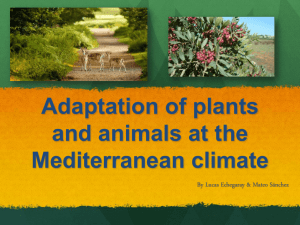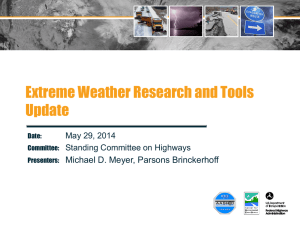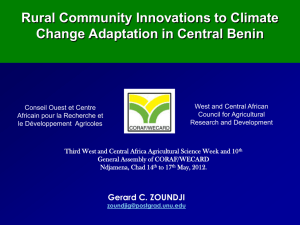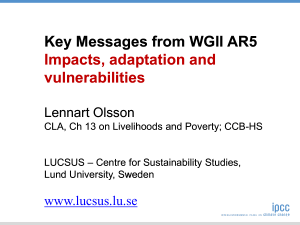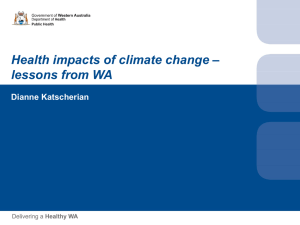- UNDP-ALM
advertisement
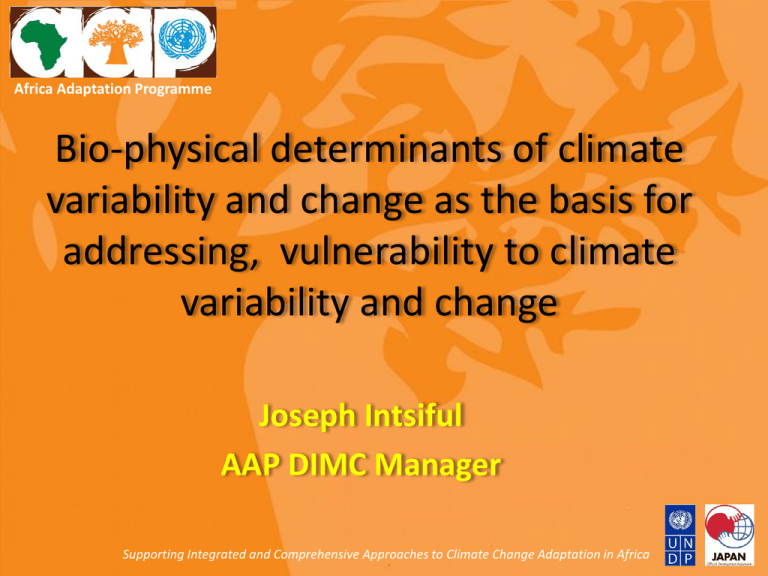
Africa Adaptation Programme Bio-physical determinants of climate variability and change as the basis for addressing, vulnerability to climate variability and change Joseph Intsiful AAP DIMC Manager Supporting Integrated and Comprehensive Approaches to Climate Change Adaptation in Africa Africa Adaptation Programme Content • Background – Our earth climate system • Observed and predicted trends in climate extremes and implications for development and of adaptation planning • Bio-physical assessment of current vulnerability example with Accra using FAO NewLoClim • Summary and Conclusion Supporting Integrated and Comprehensive Approaches to Climate Change Adaptation in Africa Africa Adaptation Programme Background – Our earth climate system Supporting Integrated and Comprehensive Approaches to Climate Change Adaptation in Africa Africa Adaptation Programme What is the Climate System? • The complicated system consisting of various components, including the dynamics and composition of the atmosphere, the ocean, the ice and snow cover, the land surface and its features, the many mutual interactions between them, and the large variety of physical, chemical and biological processes taking place in and among these components. • Climate refers to the state of the climate system as a whole, including a statistical description of its variations Supporting Integrated and Comprehensive Approaches to Climate Change Adaptation in Africa Our earth Climate System Africa Adaptation Programme Supporting Integrated and Comprehensive Approaches to Climate Change Adaptation in Africa Africa Adaptation Programme What drives the Climate? Earth’s annual and global mean energy balance Supporting Integrated and Comprehensive Approaches to Climate Change Adaptation in Africa Africa Adaptation Programme Concept of Climate Variability and Radiative Forcing Changes in certain components of the climate system perturb the radiative energy budget of system, i.e. provide a radiative forcing. Examples include: • the concentration of radiatively active species • solar irradiance • changes affecting radiation absorbed by the surface Human induced perturbations include: • composition of the atmospheric gases • increases in atmospheric aerosols • land-use change (agriculture, deforestation, reforestation, afforestation, urbanisation, traffic, …) Supporting Integrated and Comprehensive Approaches to Climate Change Adaptation in Africa Natural variability of climate Africa Adaptation Programme External forcings: • solar radiation • volcanic eruptions - aerosols source into the atmosphere Internal climate variability: • ENSO • NAO and other leading modes of variability Supporting Integrated and Comprehensive Approaches to Climate Change Adaptation in Africa Human-induced climate variations Africa Adaptation Programme • Perturbations of the atmospheric composition - the enhanced greenhouse effect • Effect of aerosols: • direct effect (scattering of incoming solar radiation) • indirect effect (affecting the radiative properties of clouds) • Land-use change (agriculture, deforestation, reforestation, afforestation, urbanisation, traffic, …) Supporting Integrated and Comprehensive Approaches to Climate Change Adaptation in Africa Africa Adaptation Programme Observed and predicted trends in climate extremes and implications for development and of adaptation planning Supporting Integrated and Comprehensive Approaches to Climate Change Adaptation in Africa Disasters Caused by Natural Hazards & their Impacts in Africa (1980-2007) Africa Adaptation Programme N u m b er o f d isaster even ts - 1980-2007 (R A I) E a rth qu a k e W ild F ire s 1% V o lca n o 1% D ro u gh t 3 % 11% W in d S to rm E pide m ic 37% 9% S lide s 1% F lo o d In s e ct In fe s ta tio n 4% 32% E x tre m e T e m pe ra tu re 1% 96 % of events 99 % of casualties 50 % of economic losses are related to hydro-meteorological hazards and conditions Source: The OFDA/CRED International Disaster Database E co n o m ic lo sses - 1980-2007 (R A I) C a s u a ltie s - 1 9 8 0 -2 0 0 7 (R A I) D ro u gh t 1 9 .6 % F lo o d 2% W a v e / S u rge D ro u gh t E pide m ic 18% W in d S to rm 1 1 .8 % 0 .9 % 79% F lo o d 1 8 .5 % E a rth qu a k e 4 8 .9 % E a rth qu a k e 1% Supporting Integrated and Comprehensive Approaches to Climate Change Adaptation in Africa Africa Adaptation Programme Impacts of Climate-Related Extremes on the Rise ! Hazard intensity and frequency increasing linked to climate variability and change! Energy Transportation Water Resource Management Intensity Strong Wind People Agriculture Heavy rainfall / Flood Urban areas Vulnerability and exposure on the rise ! Drought Need for long-term planning to manage multi-sectoral risks Heatwaves Supporting Integrated and Comprehensive Approaches to Climate Change Adaptation in Africa Frequency Downscaling Challenges Africa Adaptation Programme … from a global climate model (GCM) grid to the point of interest. Supporting Integrated and Comprehensive Approaches to Climate Change Adaptation in Africa High Resolution Climate Models Africa Adaptation Programme Requirement for simulating extreme events e.g. tropical cyclones © Crown copyright Met Office Supporting Integrated and Comprehensive Approaches to Climate Change Adaptation in Africa Nature of the Problem Africa Adaptation Programme • Over 88 % are challenged in delivering climate products and services • 92% lack appropriate software • 96% need upgrading of operational infrastructure • 92% need training on climate products and services • 85% say lack of effective co-ordination with other agencies impacts negatively on operations Source: 2006 WMO Country-level DRR survey) Supporting Integrated and Comprehensive Approaches to Climate Change Adaptation in Africa Africa Adaptation Programme Short to medium term weather forecasts • • Data and Information for Adaptation Planning Seasonal to interannual climate forecasts Decadal climate trend analysis Climate change scenarios Next hour to 10 days Season to year Decade Long term climate change Short-term planning Emergency Preparedness • Medium-term operational planning • Risk assessment and management • Long-term strategic planning • Infrastructures planning, retrofitting • Land zoning International negotiations with national policy implications Decision-making Timelines Supporting Integrated and Comprehensive Approaches to Climate Change Adaptation in Africa Africa Adaptation Programme Bio-physical assessment of current vulnerability example with Accra using FAO NewLoClim Supporting Integrated and Comprehensive Approaches to Climate Change Adaptation in Africa Africa Adaptation Programme Climate variables Evap: Greeen; Rain:Red Sunshine: Hours(B),Fract(R), length(G) Temp: Max(B),Mean(R), Min(G) Wind: Greeen; Vap Press:Red Supporting Integrated and Comprehensive Approaches to Climate Change Adaptation in Africa Vegetation Period Africa Adaptation Programme Method Nearest Neighbour Nr. Total Type Length Begin Begin End End Humid 1 Humid 1 Humid 1 Humid 1 Humid 1 Days Date Day Date Day Length [Days] Begin [Date] Begin [Day]End [Date]End [Day] 1 2 3 125 24-Mar 83 26-Jul 207 69 6-May 126 13-Jul 194 2 2 2 40 5-Sep 248 14-Oct 287 Supporting Integrated and Comprehensive Approaches to Climate Change Adaptation in Africa Current Climate Analysis Africa Adaptation Programme Climatic Information for Accra Longitude: -0.16° Latitude: 5.6° Altitude: 60m Koeppen Class: BSh B = Arid Climate S = Steppe h = hot Budyko Climate: Steppe Radiation index of Dryness: 2.083 Budyko Evaporation : 730 mm/year Budyko Runoff : 81 mm/year Budyko Evaporation : 90 % Budyko Runoff : 10 % Aridity: dry subhumid Aridity Index: 0.58 Moisture Index: -42 %. DeMartonne Index: 22 Precipitation Deficit: 597 mm/year Climatic net primary production: 1249 g(DM)/m2/year, NPP(Temperature): 2590 g(DM)/m2/year NPP(Precipitation): 1249 g(DM)/m2/year NPP is precipitation limited. Supporting Integrated and Comprehensive Approaches to Climate Change Adaptation in Africa Africa Adaptation Programme Summary & Conclusion Supporting Integrated and Comprehensive Approaches to Climate Change Adaptation in Africa


